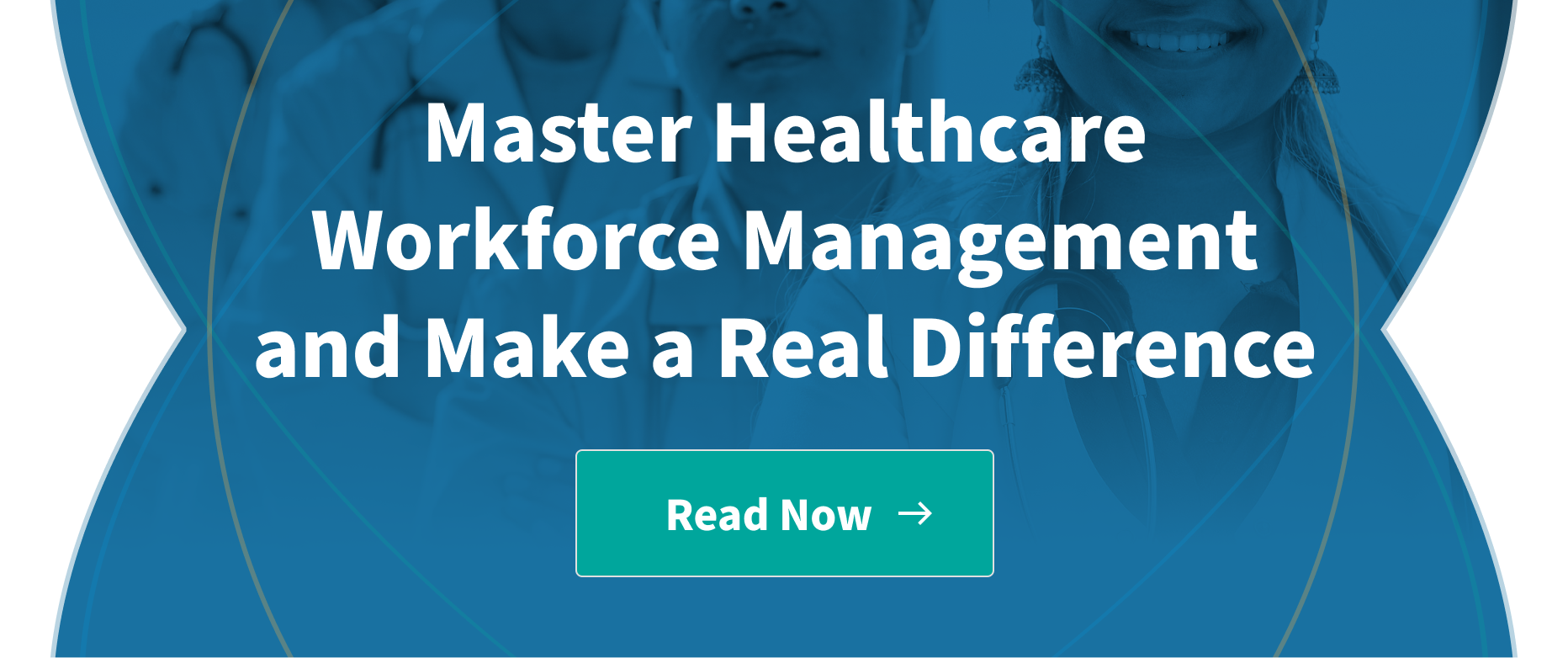Benjamin Franklin is quoted as saying, “If you fail to plan, you plan to fail.” The same holds true in healthcare as it does in many industries. Healthcare workforce planning is critical if your organization wants to ensure smooth operations through increased administrative workforce efficiency. That’s why in this post, we’re going to examine the significance of workforce planning in healthcare organizations and the challenges they face in managing their workforce. Our goal is to shed light on the roles and benefits of effective and strategic workforce planning in healthcare. Let’s dive in.
A Brief Overview of Workforce Planning in Healthcare
Efficient resource management depends on healthcare workforce planning. It involves strategically aligning the healthcare workforce with the organization's needs.
Analyzing staffing requirements, identifying skill gaps, and projecting future workforce needs are just a few things to consider when planning.
Key objectives include:
- Ensuring adequate staffing levels
- Enhancing patient care, and
- Optimizing workforce utilization.
Through effective implementation of workforce planning, healthcare organizations can align their staffing strategies with their broader organizational goals.
Benefits of Effective Workforce Planning
Just a few of the benefits you’ll enjoy with proper healthcare workforce planning include, but aren’t limited to:
- Administrative workforce efficiency: You can manage workforce onboarding, schedules, and spend within your organization in a more efficient manner with a lot more ease.
- Improved patient care and outcomes - Proper planning of your workforce ensures the right number of qualified staff are available when needed.
- Enhanced staff satisfaction and retention - When you have enough people on staff and operations are running smoothly, you create a more balanced workload, thus promoting a more positive work environment.
- Increased cost savings and resource optimization - Allocating staff efficiently based on patient demand means you won’t have personnel standing around wasting their time. And, you won’t have overworked staff members that increase the number of times they need to call out sick due to burnout and overwhelm.
If you’re lucky, you will also enjoy a decrease in your turnover rate which can mean saving even more money and resources!
Business News Daily reported that companies spend upwards of $4,000 to bring on a new staff member.
This number can skyrocket depending on the personnel you need to hire. When you keep your staff happy, they are more likely to stick around which can save your organization thousands, if not hundreds of thousands of dollars depending on the size of your company.
- Ensured continuity of care - Strategic healthcare workforce planning also mitigates risks and contingencies by having backup plans in place for unexpected staffing needs. When your patients are cared for in a timely fashion, you will also enjoy an increase of patient satisfaction which in turn can boost your reputation and ultimately your bottom line too.
Workforce Planning in Healthcare - Key Components to Consider

The question is, where do you begin with effective healthcare workforce planning? Here are a few of the key components involved:
Workforce analysis and forecasting
Workforce analysis and forecasting is a critical aspect of effective healthcare workforce planning. It begins by meticulously gathering and analyzing data on the current and future workforce needs of the organization. This data-driven approach allows healthcare providers to gain valuable insights into staffing requirements and identify potential gaps or surpluses.
Projecting demand based on patient volume, acuity, and other factors helps healthcare organizations align their workforce with patient care needs. This way they’ll have the right number of qualified professionals available at the right time. Meticulous analysis and strategic forecasting aids healthcare providers in optimizing their workforce, enhancing patient care, and adapting to healthcare industry demands.
Talent acquisition and retention strategies
The first step for this component is to assess your organization’s unique recruitment and retention challenges in healthcare. Are you offering competitive salaries and benefits? What is your turnover rate? How is personnel satisfaction? All of these elements can determine how difficult it will be to recruit and retain personnel.
It’s a good idea to work on developing strategies to attract and retain qualified healthcare professionals as well. A great place to start in determining how to go about attracting new people is to talk to your current ones. See what they like and don’t and how you can improve. Then, create packages that fit.
Skill mix and competency assessment
Healthcare organizations must thoroughly analyze the required skills and competencies for each role within their workforce. Identifying skill gaps is also essential to understand areas that may require improvement or additional training. Implementing targeted training and development programs ensures healthcare providers can empower their staff to continually enhance their capabilities. The end result is the delivery of high-quality care and staying ahead.
Succession planning and career progression
Organizations must proactively develop plans for leadership continuity and talent development to ensure a smooth transition of critical roles and responsibilities. Creating clear pathways for career advancement and professional growth gives healthcare providers a way to foster a culture of continuous learning and development. This also helps motivate employees to thrive in their roles and aspire to higher positions. Emphasizing succession planning and career progression not only boosts staff morale but also strengthens the organization's capacity to meet future challenges and excel in delivering exceptional patient care.
Best Practices for Effective Workforce Planning
Strategic healthcare workforce planning is essential for making informed financial decisions, supporting your healthcare team, and improving patient care. With this in mind, here's a list of best practices for effective workforce planning in healthcare:
- Collaboration between HR, department leaders, and executives: Work together to understand workforce needs and goals.
- Alignment of workforce planning with strategic goals and objectives: Ensure staffing solutions support organizational growth and objectives.
- Regular evaluation and adjustment of workforce plans: Stay adaptable in a dynamic healthcare environment.
- Incorporation of data analytics and technology in workforce planning processes: Use data-driven insights for optimized resource allocation.
- Cross credentialing and provider engagement: Maintain a backup roster of available providers by leveraging existing privileges. Make sure you are leveraging your network of provider relationships across facilities in your organization.
Examples of What Successful Healthcare Workforce Planning Might Look Like in Practice
Assume for a moment that a hospital implemented a workforce planning initiative to address their high nursing turnover rate. They might collaborate with HR, department leaders, and nursing staff to identify the key factors contributing to turnover. Through data analytics and staff feedback, they may discover that inadequate training and lack of career progression opportunities were major concerns. To tackle this, the hospital can then revamp their onboarding process and introduce a career development program with clear pathways for advancement. As a result, nursing turnover could then decrease by 30% within a year, leading to improved patient care and increased staff satisfaction.

Now let’s explore what might happen if a medical group faced challenges in attracting and retaining specialized physicians in their cardiology department. To address this, they might align their workforce planning with strategic goals, focusing on creating a talent pipeline for cardiology specialists. They could then collaborate with medical schools and industry associations to establish partnerships for recruitment. Additionally, they could provide attractive incentives and benefits packages to retain their existing specialists. A workforce planning initiative like this could result in a 20%-30% increase or higher in the number of cardiology specialists within two years, enhancing patient care and the group's reputation.
Are you starting to see the value in strategic workforce planning in healthcare? We hope so!
Overall, successful workforce planning initiatives have a profound impact on healthcare organizations, resulting in improved patient care, increased staff satisfaction, and optimized resource utilization.
Challenges and Potential Solutions
We’d be remiss if we didn’t share that there are also some challenges in healthcare workforce planning. Let’s take a look at a few of these challenges and their solutions that you might be able to utilize for your organization.
Common Challenges Faced in Healthcare Workforce Planning
- Shortage of Skilled Healthcare Professionals: The healthcare industry often faces a shortage of qualified and specialized healthcare professionals, leading to difficulties in meeting patient demands and maintaining quality care.
- High Turnover Rates: Healthcare organizations experience high turnover rates due to factors like job stress, burnout, and competitive job opportunities, resulting in increased recruitment and training costs.
- Rapidly Changing Healthcare Landscape: Healthcare is a dynamic field with evolving regulations, advancements in technology, and shifting patient demographics, making long-term planning challenging.
- Uncertain Future Workforce Needs: Predicting future workforce requirements accurately is complex, as factors like population growth, changing patient needs, and healthcare trends are uncertain.
Potential Solutions and Strategies to Overcome These Challenges
- Talent Pipeline Development: Healthcare organizations can invest in creating talent pipelines by partnering with educational institutions, offering internships, and providing career development programs to attract and retain skilled professionals.
- Focus on Employee Engagement: Improving employee engagement through work-life balance initiatives, recognition programs, and career advancement opportunities can help reduce turnover and increase staff satisfaction.
- Agile Workforce Planning: Adopting an agile approach to workforce planning allows healthcare organizations to respond quickly to changing demands and adapt their staffing strategies accordingly.
- Data-Driven Planning: Leveraging data analytics and workforce management software can help healthcare organizations make informed decisions, analyze trends, and predict future workforce needs more accurately.
- Succession Planning: Implementing robust succession planning ensures leadership continuity and talent development, helping healthcare organizations identify and groom internal talent for future leadership roles.
- Collaboration and Communication: Foster collaboration between HR, department leaders, and executives to ensure a holistic understanding of workforce needs and align planning with strategic goals.
By addressing these challenges and implementing suitable solutions, healthcare organizations can strengthen their workforce planning efforts, leading to better patient care, increased staff satisfaction, and improved overall performance in the healthcare industry.
Workforce Planning Can Be Easier
As we’ve demonstrated throughout this post, workforce planning plays a vital role in shaping the success of healthcare organizations. By aligning staff resources with patient needs and strategic objectives, effective workforce planning leads to improved patient care, enhanced staff satisfaction, and cost savings. If you’re in the market for workforce management software, we recommend Kimedics.
With the Kimedics workforce management platform, you get a comprehensive software solution to efficiently manage and collaborate with healthcare providers, operators, and vendor partners. Say goodbye to administrative burdens and embrace real-time data, advanced analytics, and mobile-friendly features that make workforce planning a breeze.
As the healthcare landscape continues to evolve rapidly, ongoing workforce planning becomes essential for maintaining agility and adaptability. We urge healthcare organizations to prioritize and invest in workforce planning practices that leverage data-driven insights, foster collaboration, and promote employee engagement. Experience the ease and efficiency of Kimedics, and take your healthcare organization to new heights of success. Let's revolutionize healthcare workforce planning together!
Ready to streamline your healthcare workforce planning and focus on what matters most – improving patient care? Click here to book a demo with us and see what we can do for your healthcare organization today!


